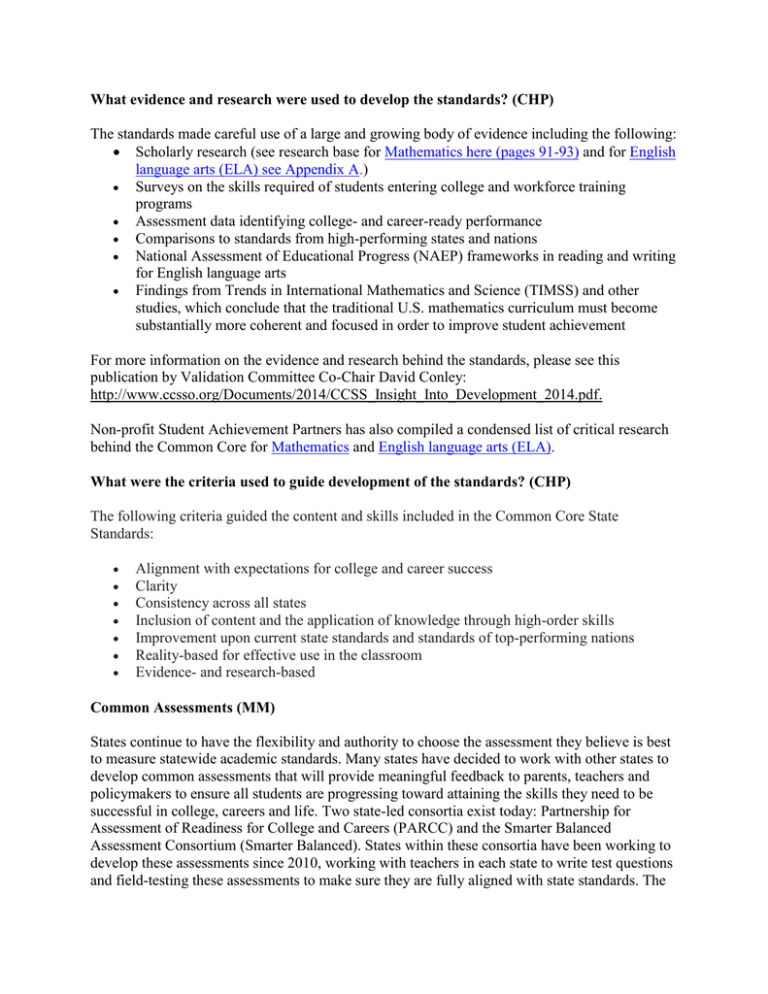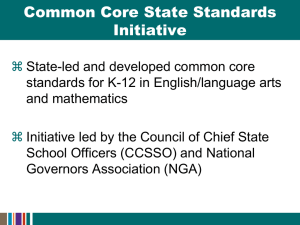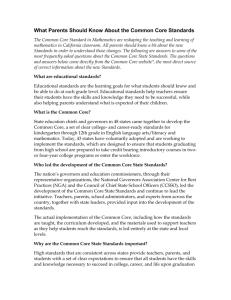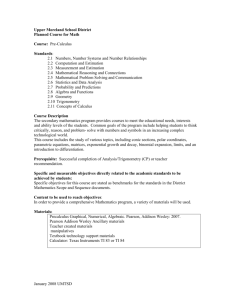Frequently-Asked-Questions-9.11.15
advertisement

What evidence and research were used to develop the standards? (CHP) The standards made careful use of a large and growing body of evidence including the following: Scholarly research (see research base for Mathematics here (pages 91-93) and for English language arts (ELA) see Appendix A.) Surveys on the skills required of students entering college and workforce training programs Assessment data identifying college- and career-ready performance Comparisons to standards from high-performing states and nations National Assessment of Educational Progress (NAEP) frameworks in reading and writing for English language arts Findings from Trends in International Mathematics and Science (TIMSS) and other studies, which conclude that the traditional U.S. mathematics curriculum must become substantially more coherent and focused in order to improve student achievement For more information on the evidence and research behind the standards, please see this publication by Validation Committee Co-Chair David Conley: http://www.ccsso.org/Documents/2014/CCSS_Insight_Into_Development_2014.pdf. Non-profit Student Achievement Partners has also compiled a condensed list of critical research behind the Common Core for Mathematics and English language arts (ELA). What were the criteria used to guide development of the standards? (CHP) The following criteria guided the content and skills included in the Common Core State Standards: Alignment with expectations for college and career success Clarity Consistency across all states Inclusion of content and the application of knowledge through high-order skills Improvement upon current state standards and standards of top-performing nations Reality-based for effective use in the classroom Evidence- and research-based Common Assessments (MM) States continue to have the flexibility and authority to choose the assessment they believe is best to measure statewide academic standards. Many states have decided to work with other states to develop common assessments that will provide meaningful feedback to parents, teachers and policymakers to ensure all students are progressing toward attaining the skills they need to be successful in college, careers and life. Two state-led consortia exist today: Partnership for Assessment of Readiness for College and Careers (PARCC) and the Smarter Balanced Assessment Consortium (Smarter Balanced). States within these consortia have been working to develop these assessments since 2010, working with teachers in each state to write test questions and field-testing these assessments to make sure they are fully aligned with state standards. The tests were fully administered for the first time in the 2014-2015 school year. For more information on the test your state has chosen to use as one measure of a student’s academic progress each year, visit your state education agency website or download the National PTA’s assessment guide for your state. Additionally, there are two state-led consortia working through the National Center and State Collaborative Partnership (NCSC) and the Dynamic Learning Maps Alternative Assessment System Consortium (DLM) to create a new generation of assessments for students with the most significant cognitive disabilities. There are also two stateled consortia, ASSETS and ELPA21, developing assessments for English language learners. What does this work mean for students with disabilities and ELLS The National Governors Association Center for Best Practices and the Council of Chief State School Officers strongly believe that all students should be held to the same high expectations outlined in the Common Core State Standards. However, how students meet these expectations will and should differ based on children’s needs. For more specific information on the application of the Common Core State Standards for students with disabilities, please click here, and for information on application for English language learners, please click here. Additionally, the Common Core State Standards give states the opportunity to share experiences and best practices, which can lead to an improved ability to serve young people with disabilities and English language learners. Who led the development of the CCSS? (OM) States led the development of the Common Core State Standards. In 2009, state leaders, including governors and state commissioners of education from 48 states, two territories and the District of Columbia, came together and decided to develop common, college and career-ready standards in mathematics and English language arts. They worked through their membership organizations – the National Governors Association Center for Best Practices (NGA Center) and the Council of Chief State School Officers (CCSSO) to accomplish this. The development process included defining expectations for what every child should know and be able to do when they graduate from high school and then creating content standards for grades K-12 aligned with these expectations. States relied on workgroups of educators, representatives of higher education and other experts to write the standards with significant input from the public in 2009 and 2010. States then appointed a validation committee to review the final standards. The final standards were published in June 2010 and available for each state to review, consider and voluntarily adopt. More detailed information on the development process is available in the complete timeline of the process or The Common Core State Standards: Insight into their Development and Purpose paper. What are educational standards? (CHP) Educational standards are the learning goals for what students should know and be able to do at each grade level. Education standards, like Common Core are not a curriculum. Local communities and educators choose their own curriculum, which is a detailed plan for day to day teaching. In other words, the Common Core is what students need to know and be able to do, and curriculum is how students will learn it. The Common Core State Standards are educational standards for English language arts (ELA)/literacy and mathematics in grades K-12. Please click here to read the ELA Common Core State Standards and click here to read the mathematics standards. Are the standards developmentally appropriate for students? (SG) The expectations of students in the Common Core State Standards are backed by research and the expertise of educators of what is developmentally appropriate for children to know and be able to do in literacy and math in early grades. For more detailed information on what the Common Core says about English Language Arts and Literacy in Kindergarten and the research supporting it, please take a look at this fact sheet compiled by Student Achievement Partners. As or perhaps more important for standards being developmentally appropriate is how standards are taught, which is determined locally by communities and educators. An example is how this might work with the kindergarten math standard, “Fluently add and subtract within 5.” It is developmentally appropriate to expect students by the end of kindergarten to be able to do this. However, it is not developmentally appropriate for kindergarteners to be sitting quietly alone at their desks completing worksheets for 30 minutes on adding and subtracting within 5. It would be developmentally appropriate for kindergarteners to be playing a game with other children that helped them build this skill, with a teacher supporting and guiding their learning. In fact, the standards themselves point to the importance of play stating, “[T]he use of play with young children is not specified by the Standards, but it is welcome as a valuable activity in its own right and as a way to help students meet the expectations in this document.” The standards welcome play and encourage implementation of instruction that is play-based, engaging, and cognitively enriching. Early childhood experts and national education organizations have discussed research supporting the developmental appropriateness of the Common Core State Standards including the National Association for Education of Young Children, the Thomas B. Fordham Institute, and early childhood expert Douglas Clements. Is adoption of the standards voluntary? (OM) Yes. Adoption of the standards is voluntary. It is up to each state and territory to decide if they choose to adopt the Common Core State Standards as their state educational standards in English language arts and mathematics. States can tailor the standards to address their needs. Here is a map showing the states that have adopted the standards. How can I help my child meet the goals of the Common Core? (SG) The Common Core State Standards provide clear and transparent benchmarks that parents can use to track if their children are on the path toward college and career readiness. Still, these are higher standards and parents may find the methods and approaches different or have difficulty helping their children with homework as states transition to these standards. Fortunately, these standards provide a great starting point for parents to have a conversation with their child’s teacher about what their child should be learning in the classroom and how families may be able to help their children outside of school. Additionally, online resources such as Be a Learning Hero are designed to assist parents in helping their children. This site includes resources developed to support your child’s learning in Math and English language arts at home. Parents can search by state, grade, subject and type and access resources to support children outside of the classroom. Where can I find the Common Core State Standards for ELA and Mathematics?(CHP) To read the Common Core State Standards, please visit this link. To view the standards in Spanish, please see this translation of the standards. Many states have customized the Common Core State Standards to fit their local state needs and context. To view the standards in your state, visit your state education agency website, which can be found at this link. How can I tell if texts are aligned to the Common Core State Standards? The standards are not curricula and do not mandate the use of any particular curriculum. Therefore, the Common Core State Standards does not prescribe instructional materials or lessons. States and organizations have come up with tools and rubrics to help inform decisions about purchasing materials and build understanding of what aligned materials look like. There are groups that help communities make better informed decisions such as EdReports.org, EQuIP, IMET, and the Textbook Navigator. Myth v fact: Add Be a learning hero link for math question





